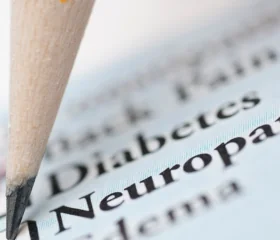Managing Insulin Therapy: Unique Considerations for Women with Diabetes

With diabetes management, there are always “special considerations” we need to be aware of and adapt to for obtaining and maintaining glucose goals. This article is going to talk about a few of these special considerations when it comes to diabetes management, especially with insulin therapy.
The first area of consideration is the effect of other medications on blood glucose. As much as we want to minimize the amount of medications that we take there are times where we need to add medicine, maybe short term or for a longer period. These medications, and sometimes the affliction they are being used to treat, can make glucose control harder. One of the biggest culprits would be steroids. Steroids, either prednisone or methylprednisolone, are both commonly used to treat poison ivy, asthma flare, COPD flare, muscular strains, and a whole host of inflammatory diseases. The strain to the body from the illness or allergic reaction can in and of itself elevate the blood glucose, but the steroid also will elevate the glucose further by making the body temporarily more insulin resistant. Even a short 3-5 day course of steroids can cause havoc. This is something to be aware of and at the very least monitoring of blood glucose should be increased, but additional insulin during the time of treatment with steroids may be necessary to maintain glucose goal levels. Another group of medications that could increase blood glucose are fluoroquinolone antibiotics, ciprofloxacin, levofloxacin and ofloxacin are commonly used to treat respiratory or bladder infections. Again the infection itself can increase the glucose, but there is an additive effect from the antibiotic. There are a few families of medications used for chronic diseases that will increase blood glucose levels. Typically because they will be used for an extended period the insulin therapy is adjusted to compensate for the slight elevation of glucose they may cause. These medications include thiazide diuretics and beta-blockers – used for blood pressure control, statins – used for high cholesterol, and some immunosuppressants – used for organ transplants. All of these have a small effect of the blood glucose, but there are a few that have a much larger effect. These families of medications would include atypical antipsychotics – used for depression, bipolar or schizophrenia, and protease inhibitors – used in HIV management. Again, because these medications are needed for chronic illnesses the insulin dosing would be adjusted to compensate for the effect of the medication, it is just good to be aware that this might occur.
As women with diabetes another area of special considerations would have to be the effect that our hormones have on our bodies, especially at different times in our lives. Throughout our reproductive years we have continual changes in insulin sensitivity with every monthly cycle. The presence of progesterone can cause insulin resistance and the lack of estrogen can also cause insulin resistance. In the normal menstrual cycle estrogen is high at the first of the cycle and begins to decline around ovulation when progesterone begins to increase. This leads to increasing insulin resistance towards the end of the cycle. Many women need to adjust their insulin dose as the cycle progresses to keep glucose levels in check. Pregnancy is another time in a woman’s life that glucose control is extremely important but the changes that are occurring will make control more challenging. It is recommended that any woman with diabetes prior to conception should achieve an A1C goal of <6.5% prior to pregnancy. As pregnancy progresses the body becomes more insulin resistant so monitoring blood glucose at fasting and after meals becomes extremely important. By the third trimester insulin needs can increase significantly but then revert very quickly after delivery. Monitoring and adjusting will be key to a successful pregnancy. Finally in menopause women again have changes in their hormone levels that can effect their insulin needs. As estrogen levels begin to fall in menopause insulin resistance begins to increase. Women can also begin to gain weight during menopause that can contribute to insulin resistance. Due to increased insulin resistance there may be a need to increase insulin dosing to maintain optimal glucose control.
Insulin is a fantastic medication for lowering blood glucose in people with type 1 and type 2 diabetes. But this glucose-lowering effect can lead to a life-threatening emergency, hypoglycemia. This is the third special consideration – hypoglycemia, its cause, how to be on the lookout for it, and how it is treated.
Hypoglycemia or low blood glucose is a serious complication of diabetes management. If your blood glucose therapy includes insulin or sulfonylureas, then you are at risk of hypoglycemia. But what exactly is hypoglycemia? The American Diabetes Association (ADA) defines hypoglycemia into Level One, Level Two, or Level Three hypoglycemia. Level One would be a blood glucose <70 mg/dL but >54mg/dL. Level Two is blood glucose <54mg/dL and Level Three is severe hypoglycemia when there is altered physical or mental status that requires assistance to treat the low glucose level regardless of what the blood glucose level is at time of incident.
But why would hypoglycemia occur? There are many reasons why someone might experience hypoglycemia, but it boils down to a few main points; too little food, too much activity, too much insulin, or a combination of all three. So if life happens and maybe you got too busy to have lunch the insulin you injected is still working and could push you into hypoglycemia. Or your run after work felt great so you run an extra few miles, that extra exertion could result in low blood glucose if you don’t follow it with enough food or lower your insulin dose at dinner.
There are warning signs for hypoglycemia. Most common symptoms include shakiness, headache, anxiety/irritation, cold clammy sweating, confusion, hunger, nausea, fast heartbeat, confusion, feeling exhausted, tingling of lips/tongue/cheeks, coordination problems, and seizures. Not all of these are present in every case of hypoglycemia. One might be more prevalent for you, so be aware of how you are feeling and check your blood glucose if you are unsure as to why you might be feeling a certain way. Many people will start to realize they have a progression of symptoms as their blood glucose levels drop. Maybe they start off with a slight headache, but as the glucose levels get lower, they become shaky, then sweaty, then confused. Everyone is different and experiences hypoglycemia differently. If you experience hypoglycemia often this can lead to hypoglycemic unawareness. In hypoglycemic unawareness the first symptoms of low glucose are masked, either they are lessened or not present at all. This can be dangerous because the blood glucose can be extremely low before the person with unawareness realizes that they are in trouble. They might be in severe hypoglycemia needing assistance to treat the episode before they even know they are experiencing hypoglycemia. For people experiencing hypoglycemia unawareness continuous glucose monitors can be extremely helpful for monitoring glucose levels, catching the trend towards hypoglycemia so it can be treated quickly. By not having hypoglycemic events the unawareness can be corrected over time.
The goal is to never have hypoglycemia, but with insulin and sulfonylurea therapy it is a real risk so you should be prepared and know how to treat it appropriately if it should happen. There is an easy rule to remember for treating hypoglycemia.
The RULE OF 15 for hypoglycemia:
1: Check your blood glucose or continuous glucose monitor.
2: If your blood glucose is 70 or less or you have trending arrows indicating rapid blood glucose decline treat with 15 grams of fast carbohydrates.
- Examples of 15 grams fast carbohydrates:
- 3-4 glucose tablets
- 4 oz fruit juice
- 6 oz cola (the real thing not diet or zero)
- A handful of Skittles
- 5 Life Savers Candy
- 1 tube cake GEL icing
3: Wait 15 minutes and recheck blood glucose or continuous meter trending arrows
4: If blood glucose is above 70mg/dL and rising either eat a snack that includes protein and fat or if it is time for a meal go ahead and eat the meal. If blood glucose is not above 70mg/dL or trending up, then repeat steps 2 and 3.
Sometimes blood glucose can get so low that you are unable to treat with 15 grams of carbohydrates due to altered state of consciousness. In this situation glucagon might be the more appropriate treatment, especially if you are not coherent enough to treat yourself. Glucagon kits have been available for years and years. These kits must be mixed and then administered through IM injection by a caretaker or loved one. This can be difficult, even for someone who has been trained, because it needs to be done in an emergency situation and hopefully it has not been done very often. In the past few years newer glucagon administration devices have been developed and are on the market. One device is the G-voke glucagon pen. This device is prefilled with glucagon that is already mixed and is stable for 30 months after manufacturing. It is easy to administer. Pull off the red cap, push the yellow end down on the skin of the upper arm, stomach or thigh and hold for 5 seconds until the window turns red. If you want to watch the video demonstration, click on the G-voke link above or go to Gvokeglucagon.com and click on the video. The other newer device is the Baqsimi nasal glucagon which is a dry powder form of glucagon. It comes as a single dose spray that is administered into the nose. You can see a demonstration video of Baqsimi using the link above or by going to Baqsimi.com. Both of these new preparations are stored at room temperature. If you visit the websites there are also manufacture coupon cards that you can download and take to your pharmacy. This could lower your copay to $25 for G-voke and Baqsimi depending on your insurance coverage.
My hope is that you will never have severe hypoglycemia, but it is wonderful that we have products that are easy to use and effective in rescuing someone from severe hypoglycemia. If glucagon is needed to treat hypoglycemia it is a good idea to also call 911 because further treatment may be necessary to get the glucose levels back to normal and stabilized.
The key points to remember about hypoglycemia are:
1: Insulin or sulfonylurea therapy increases the risk of hypoglycemia.
2: In general hypoglycemia is blood glucose <70mg/dL but severe hypoglycemia is when you need assistance to manage treatment regardless of the blood glucose level.
3: Hypoglycemia is caused by too little food, too much exercise, too much insulin or a combination.
4: Rule 15 is used to treat hypoglycemia that is not severe.
5: Glucagon is used to treat severe hypoglycemia, and your friends and family need to know how to use the glucagon device.
View References
1: Diabetes Care 2024; 47(Suppl.1):SS1-S309 / https://doi.org/10.2337/cd24-S005
2: Canagliflozin [package insert]. Titusville, NJ: Janssen Pharmaceuticals, Inc.; 2022.
3: Dapagliflozin [ package insert]. Wilmington, DE: AstraZeneca Pharmaceuticals LP; 2022.
4: Empagliflozin [package insert]. Ridgefield, CT: Boehringer Ingelheim Pharmaceuticals, Inc.; 2022.
5: Dulaglutide [package insert]. Indianapolis, IN: Eli Lilly Pharmaceuticals, Inc.; 2022.
6: Exenatide [package insert]. Indianapolis, IN: Eli Lilly Pharmaceuticals, Inc.; 2022.
7: Liraglutide [package insert]. Plainboro, NJ: Novo Nordisk, Inc.; 2022.
8: Lixisenatide [package insert]. Bridgewater, NJ: Sanofi-Aventis U.S. LLC.; 2022.
9: Semaglutide [package insert]. Plainboro, NJ: Novo Nordisk, Inc.; 2022.
10: Tirzepatide [package insert]. Indianapolis, IN: Eli Lilly Pharmaceuticals, Inc.; 2022
11: https://www.drugs.com/metformin.html
12: https://www.drugs.com/sulfonylurea.html
13: Sitagliptin [package insert]. Rahway, NJ: Merck Pharmaceuticals, Inc; 2023
14: https://www.drugs.com/onglyza.html
15: Linagliptin [package insert]. Ridgefield, CT: Boehringer Ingelheim Pharmaceuticals, Inc; 2023
16: https://www.drugs.com/pioglitizone.html
17: https://www.drugs.com/drug-class/insulin.html
18. https://www.mayoclinic.org/diseases-conditions/high-blood-cholesterol/in-depth
19: https://www.mayoclinic.org/healthy-lifestyle/weight-loss/in-depth
20: https://www.drugs.com/glucagon.html
21: Gvoke [package insert]. Chicago, IL: Xeris Pharmaceuticals. 2023
22: Baqsimi [package insert]. Rancho Cucamonga, CA Amphastar Pharmaceuticals. 2019
Written by






